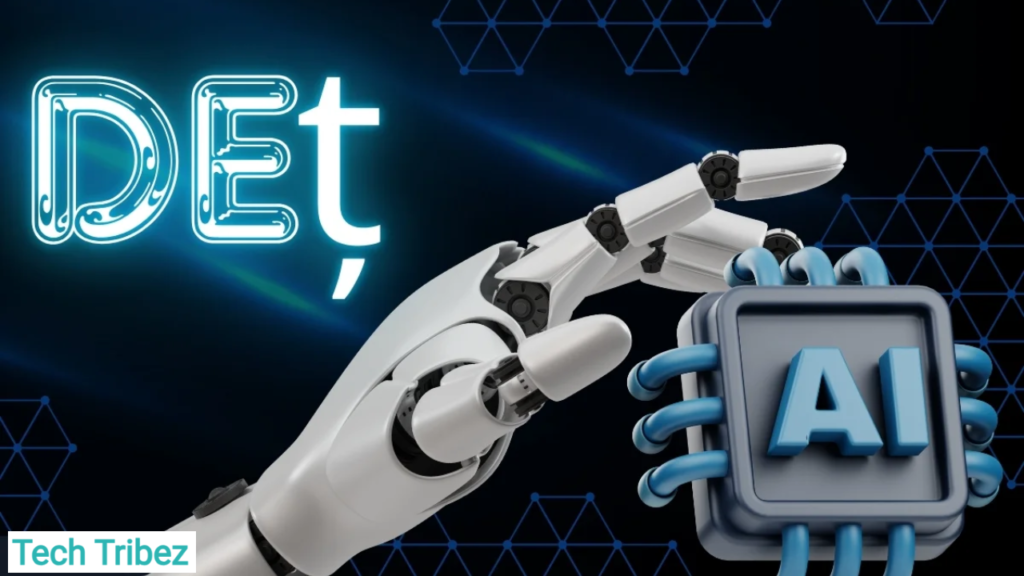Deț: The Revolutionary Technology Shaping Industries in the Digital Age

Due to the rapidly progressing trends in every field of people’s everyday lives, industries are always searching for opportunities to enhance clients’ performance, quality, and satisfaction. Among these technologies, one is Deț. A relatively new concept, it has quickly grown to become a significant driver of digital disruption across various industries.
The capacity to manage such processes, perform repetitive actions, and incorporate AI solutions into the company’s business environment makes it an irreplaceable instrument for companies that target to survive in the contemporary world. This chance led the author of this article to explain what Deț is, how it has evolved, how it is implemented today, and the exciting future that Deț entails for industries of the world.
What is Deț? A Comprehensive Overview of This Groundbreaking Technology
Thus, deț, also known as “Digital Efficiency Technology” or DET, is a complex high-tech platform for improving different business processes. In its essence, Deț uses AI and machine learning techniques to address processes that can be repetitive while allowing the system to process large data sets to help with decision-making. The main advantage of Deț over other automation technologies is reactivity and adjusting its process according to the output of data pattern analyses.
Regardless of its function as a data manager, process automation tool, or efficiency booster, Deț has emerged as a valuable tool that can help companies reach exemplary levels of productivity while maintaining the same level of precision. This approach makes processes drastically faster and dramatically reduces the error margin that can occur when people do all the work manually; this is particularly applicable to finance and healthcare sectors, manufacturing, and retail. The increasing need for Deț is explained as the ability of modern enterprises to address the increase in competition through artificial intelligence solutions.
Also Read: The Predovac Ultimate Guide to Revolutionizing Learning Efficiency in Education
The Evolution of Deț: From Concept to Industry Standard
The conception of Deț was preceded by certain preliminary circumstances – the necessity to optimize the existing work processes. When created, it was primarily designed as an application to help reduce the amount of time spent on repetitive tasks. Functions introduced using the earlier versions of Deț were aimed at reducing the occurrences of mistakes made by people when entering the data as well as increasing the efficiency by automating the processes that consumed significant amounts of effort.
Yet, based on the technological possibilities provided by artificial intelligence and machine learning, Deț developed a system offering far more elaborate functions. It was adopted into decision-making models, and it is possible to rely on predictive technologies for market trends, customer behavior, and operational slowdowns. Years later, industries saw Deț effective in saving costs, increasing precision, shortening turnaround time, and even offering insights on strategy formulations.
Now, Deț is widespread, and many companies from different countries use this tool to improve their productivity and creativity. The technology they’ve been implementing is still advancing and adapting with newer concepts of AI, machine learning, and data processing, thus ensuring it plays a vital role in future industries.
How Deț is Transforming Key Sectors: Healthcare, Finance, and More
Deț penetrates all ors and illustrates its effects in the best way possible through fields such as finance. Deț in the healthcare setting helps reduce the workload by automating patient data recording, appointments, and other payment-related functions. Deț also saves significant time for healthcare professionals, meaning that the time that would have been spent on paperwork would have been spent on treating several patients.
It also has the positive consequence of increasing the likelihood of having correct patient data about diagnosis or treatment in a patient’s medical record. In finance, Deț changes transactions by automating jobs such as fraud checking, risk evaluation, and other compliance scanners. Not only does it help increase the velocity of the transactions, but it also increases overall security, which helps make the financial operation more efficient.
Apart from healthcare and finance, Deț is revolutionizing other related industries, such as retail, manufacturing, and logistics, where the automation of processes and data-driven decision-making is paramount. Whether it is supply chain optimization or improving the organization of the production line, Deț is assisting industries in meeting the needs of the current market.
Unpacking the Benefits of Deț: Efficiency, Accuracy, and Cost Reduction
The advantages of Deț can be easily discerned and are goal-dynamic; that is why it is impossible to overestimate the importance of this technology for enterprises striving to succeed in the world of the WEB. The most significant benefit is the improvement of operating efficiency. Through outsourcing, the core and repetitive work is relieved and handled by Deț, leaving its employees to engage in value addition, such as planning and creating more solutions. It improves productivity by taking less time since more work is achieved using the same resources.

Another advantage of Deț is accuracy, an essential factor for prior achievements. Generally, manual processes are highly subjective and open to manipulation, but with Deț, businesses can get consistent responses, especially where large volumes of data are involved. Using Deț’s AI solution, it is possible to spot exceptional cases, learn the mistakes as they occur, and prevent them from happening again. In addition, cost-effectiveness has been repeatedly referred to as a key selling point for Deț. Resource management can also be optimized while automating several processes, so operational expenses will also be cut. Among all the claims, Deț can adapt to different organizational structures and assist organizations in ensuring that they operate with higher efficiency in terms of costs such as payroll.
Overcoming Challenges: How Early Adopters of Deț Paved the Way
As is usually the case with progressive technologies, some issues were related to implementing Deț. Implementation of Deț was challenging in the early phases primarily because it involved the following challenges: high implementation costs, poor integration with other systems, and resistance from personnel. Some organizations were at a loss when adapting technologies to incorporate Deț into their setup, which in most cases meant more resources needed for implementation and training. Besides, there was initial resistance from the workers, noting that automation would take away their jobs.
However, these challenges faded over time as the bot, Deț, became more mature and user-friendly. The pioneers contributed to defining Deț, bringing out the flaws, and exploring what can be done with the tool. Through success stories, the companies of the industry also proved that Deț was not anti-employment but rather a tool that may be used effectively for improving job performance by Egyptian employees once they are freed from the useless and time-consuming typing jobs. Looking at the current situation, Deț has become much more easily accessible and easier to implement than in the past due to the several early adopters who have initiated the use of the Deț and have readily encouraged others to do the same.
The Core Working Principles of Deț: AI, Automation, and Data Processing
Therefore, the core factors underpinning the application and development of Deț are AI, automation, and data processing. These three principles create synergy to present a system that mimics work procedures and improves decision-making and operations. AI is the core of Deț and the ability of the system to enhance the learning feature with data patterns. The benefits of machine learning algorithms include processing large volumes of data to make better-informed decisions using Deț.
Automation, another fundamental principle, is used to get repetitive jobs done at Deț without involving human personnel. From accepting payments to storing stock, Deț simplifies activities that would otherwise be extensive. Last but not least, through acquiring more evidence, the data processing function of Deț enables it to deal with large datasets and guarantee the efficiency of information collection, analysis, and application. Deț thus makes AI, automation, and data processing an effective solution for businesses that want to stay relevant and be at the high end of their game.
Real-World Applications of Deț in Business: Success Stories
The benefits of Deț are invaluable since many organizations have testified to receiving increased efficiency and profitability after adopting the technology. One success story is in the healthcare system where hospitals use Deț to manage Deț to manage patient data. In the following, these hospitals have cut much time on administrative processes, enabling doctors and nurses to spend more time with their patients. Deț has been adopted in the financial sector to operate the identified fraud detection procedures to ensure that the banking system identifies anomalous-looking transactions and averts financial crimes.
He also said that retailers implement Deț to improve the supply chain and better control stocks. These retailers can source for products they want to sell and stock them in a way that imitates automatic stock replenishment, making their products always available to customers and increasing their sales. The success stories showcased here show the impact of Deț and how it can potentially revolutionize many industries. Male enterprises adopting Deț benefit from improved efficiency, accuracy, and customer satisfaction.
The Future of Deț: Trends and Innovations on the Horizon
The future for Deț is, therefore, bright, given that further development in AI and machine learning will extend the possibility of this technology. Perhaps the most exciting development is the extension of Deț into the IoT domain. Deț, together with IoT devices, will allow businesses to obtain actual data from various sources, resulting in better automation and decision-making. The other progressive trend observed is the creation of progressively advanced algorithms associated with the Field of AI.
Such advances will enable Deț to assume other activities like predictive maintenance in the production sector or known-client services in the selling industry. Moreover, as Deț continues to become cheaper and more readily available on the market, companies of all sizes and types will likely adopt it more often. Indeed, through Deț, small businesses will be placed on competitive grounds with large firms due to the automation of activities. There is a lot of potential for progression in the future of Deț, and as the industries progress, technology will impose itself and become more prominent.
Implementing Deț: Steps for Seamless Integration in Your Business

Five considerations help to apply Deț in your business, which may sound a little overwhelming, but, in reality, it can be pretty easy and effective. This step focuses on evaluating your business requirements and defining the opportunities that can bring the most significant value once implemented with the help of Deț. Whether it is to define routine processes, raise the efficiency of decision-making, or improve the mode of customer service, recognizing possible Advantages of Deț for your business is an inevitable step.
The next step, as planned, is to investigate the Deț solutions and select the most appropriate system to apply. The aim here is to implement these changes. Many Deț providers in the market have different and varied facilities for use, so it is necessary to choose the respective provider that can fulfill the organizational requirements of a business. Having made a choice, it is time to go deeper and begin the integration of the selected solution. The integration usually involves liaising with ITS personnel, so Deț fits perfectly into your program. Last but not least, you should train those engaged in Deț and make them understand how it can be utilized. Application of Deț can bring about the desired and intended changes when implemented following the best practices.
Ethical Considerations of Deț: Data Privacy and Workforce Impact
Like any other technology with excellent capabilities, Deț has brought to the fore some questions of ethics, which businesses have to solve. However, there are a few issues to consider, including data privacy. This is because Deț systems are data intensive and require companies to take measures to guarantee information protection.
To that extent, measures have to be put in place and followed to ensure that customers’ and employees’ information and data are secured from those who wish to attempt accessing them. Further, it is necessary to analyze the consequences of Deț for businesses, including the employees. Even though Deț can facilitate many different types of chores, it seems poised to cause job losses because its principal application area is heavily physically intensive.
In this regard, companies need to advance training solutions that assist the employees to move to another category of work they would want to perform with skilled expertise. However, by considering ethical issues, companies can ordinate the strengths of Deț to their advantage for organizational functioning and employees. Solving these problems will become essential for the effective and sustainable use of Deț in the long term.
Conclusion
Therefore, Deț is a unique technological solution that is already in the process of changing industries as we know them. The capacity to enhance the organization’s efficiency, data reliability, and decision effectiveness is helpful for companies that desire to remain viable in the current complex environment. Since its beginnings up to modern use, Deț has been successful in hospitals, schools, companies, financial institutions, and other spheres. The future of Deț also appears to be very promising. New developments are expected, and Deț. may develop even more robust integration with present-day revolutionary technologies such as IoT.
Yet, as the business populations respond positively to Deț, they have to think about the potential ethical issues of its application, namely concerning data protection and the staff’s performance. If these concerns are attended to, companies can effectively enhance value capture by adopting Deț while simultaneously creating measures to prevent the pitfalls of its usage from materializing. Last but not least, Deț embodies the future of industries and the promise of improved performance, precision, and creativity for any global organization.



